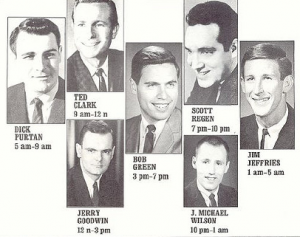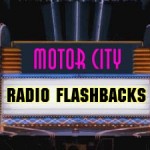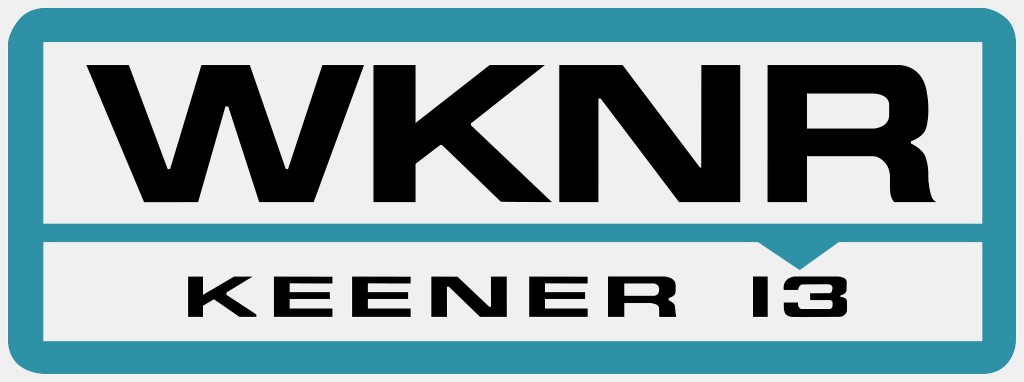From the MCRFB news archives: 1966
Billboard Hosts Music Programming Seminar; Reps from Six HOT 100 Formatted Stations Attend, Including WKNR’s Frank Maruca
R A D I O S T A T I O N S C A N N O L O N G E R switch to rock ‘n’ roll formats and automatically seize humongous audience ratings. But don’t get the idea that radio stations which depend on rock ‘n’ roll music formats are falling by the wayside. The truth is that most are doing better than ever. KYA. San Francisco, is a good example.
KYA president and general manager Clinton D. Churchill not only handle the executive chores of his station, but is deeply involved in the programming. He even picks all of the music on his station because he enjoys doing it. At this time, KYA has the highest audience rating and response it has ever had. But it doesn’t depend strictly on one factor.
“You can’t capture a large share of the market anymore by just offering 40 records and time and temperature,” Churchill said. “You must offer more — strong air personalities, audience participation features, news, contests. You must be involved in the community. One of the most successful thing we’ve ever done is organize a basketball team. All of the profits of these games goes to scholarship funds, charities.
“Through these services, we’ve been able to expand our audience . . . to offer more to a wider range of listeners.” Of course, the music that KYA plays have been changing too. And this has brought even larger audience ratings. “The quality of music being produced today has improved tremendously. An example is ‘Yesterday’ by the Beatles. And, as a result of this improvement, the music — and thereby the station — has a much wider appeal to a large segment of the audience than, say, Little Richard did several years ago. It’s true that different fads sometimes take over . . . like the British invasion. But quality prevails in the long run and now only the best British product is making it.
“We’ve enjoyed a record business year and there’s always going to be a place for this kind of station. After all, we’re playing the popular records of the day. The big sellers. And these hit records are always going to attract a major share of the audience.”
WLS GO BY SALES
Gene Taylor, station manager of WLS, Chicago, also feels that Hot 100 format stations are doing better than ever and the trend is up. And the reason is that Hot 100 stations depend on record sales. “We play some records early, the one that are just starting, but later play depends on sales.” WLS is having a record first quarter in business.
As for the future, Taylor feels that audiences are becoming very selective in their listening tastes. “If they like rock ‘n’ roll, they listen to us. If they like another type of music such as R&B or country music, they listen to another station. It has almost become a segmented thing entirely. We’ve given some thought in the past regarding aiming our music toward the audience. I think many stations today modify their sound in the morning hours . . . make it softer. This seems to be a trend . . . a tendency to more softening the sound during the day. The object is to hold what audience the station has naturally and try to gain new listeners.”
As for the music itself, Taylor noticed a “leaning away from some of the English groups. Two years ago everything was British. British groups got automatic airplay. Now only the select ones sell only enough to warrant airplay.”
WMCA ROCK IS ART FORM
Herb Mendelsohn, general manager of WMCA, New York, feels it is misleading to put a label such as “rocker” on a station. “That’s only a part of what we do. If some stations are losing numbers in ratings, it may be because of their over-all format. WMCA is doing fine and I think our audience is increasing. I’m not sure I would or wouldn’t attribute our success solely to the music. We’re trying awfully hard to be successful, though, and music is one of the ingredients along with the ‘Good Guys,’ the editorials, the news, the features we present for our audience.
“Rock ‘n’ roll music,whether applied to a radio station or not, is an art form. It may be in vogue, or out of vogue, but it’s going to be here.
“I don’t apologize in the slightest for the music we play. After all, we play a lot of different kinds of music . . . the Supremes, Herb Alpert & the Tijuana Brass, the Beatles, Herman’s Hermits. How can you call all of these artists, rock ‘n’ roll artists?
“As a station, I think we’re pretty good. But I think we can be better. The thing about this business it’s so complicated. No labels imparts the raison d’etre of a radio station. How could it when you’re dealing with so many variables? I consider WMCA a modern radio music station and I think our success is in terms of the empathy we establish with our listeners.”
FORMATS GALORE WABC
Rick Sklar, program director at WABC, New York, offered the theory that all types of formats will continue a successful growth. His reason? The population is expanding at all age levels. And the result will be “room for all.” Hot 100 format stations such as WABC can’t help having a rosy future “because more than half the population is under 25 years old. Look at the recent switch to rock ‘n’ roll by stations such as WCEL, Chicago; WYSL, Buffalo, and KRFC, San Francisco — all major stations in major markets.
“I feel there’s going to be a profusion of of stations in all different kinds of formats. Very few radio stations will be in trouble.” He did think, however, that auto stereo cartridges would limit the growth of FM stereo stations.
No one big change in music was expected by Sklar. Though he’d notice a little less of British product. “Only five tunes at the moment are British songs. We used to have as many as 15. At times, British product was all over the playlist. But now you’ve got tunes like ‘California Dreamin’,’ ‘Ballad Of The Green Berets,’ ‘These Boots Are Made For Walkin’ ‘ — would you call these rock tunes? And ‘Batman,’ what do you call it?
“If you play what the public likes, it doesn’t matter what you call it. Hot 100 stations play whatever the public is buying. Therefore, I can only see a continuous growth for the teen-aimed type of programming.”
WKNR BIG SHARE

The reason is that 25-30 per cent of the daytime market is the potential share of a Hot 100 radio station. The potential market share of a Hot 100 radio station at night is between 35-40 per cent of the audience. People tune in specifically for that type of entertainment, Sklar said.
In spite of the growing popularity of the Easy Listening format around the country, program director Frank Maruca at WKNR, Detroit, felt Hot 100 formats were in no trouble. “Our station is far and away No. 1 here. It’s true that some good music stations are dominant in some markets in the mornings. But this is nothing new; it has been this way for some while.”
WKNR does not soften its morning sound. It maintains the same playlist 24 hours a day, said Maruca. “I do feel, however, that there is probably more of an overlap between rock ‘n’ roll and good music than there has been in many years. We’re playing good music records, but only because they’re selling. We haven’t changed our method of picking records though.”
“What is happening is that good music stations are getting smart to the fact that some of the old bandleaders are not as popular as they were 15 years ago. They’re playing contemporary music now, realizing that a lot of so-called ‘beat’ records are really good music.”
But, as an example of the popularity of Hot 100 formats, WKNR is sold out in most time periods through June (1967). “We’re very successful,” said Maruca. “We’ve now completed new studios and offices.”
Maruca has noticed lately that there is “a maturity to music we’ve not seen in years.” Evidence, as cultural tastes improve, the people are becoming more selective with their music.”
BUFFALO NEW HOT 100 HOTBED
John Barga is the new program director at WYSL, Buffalo, in its new Hot 100 format. The station switched formats because “there was a feeling we could be more successful in both audiences and billings with a Hot 100 format. If rock ‘n’ roll stations are in trouble anywhere in the nation, it’s because that particular market is overloaded with that format. Here, we felt the market could use another Hot 100 station.” WYSL switched to the new format February 27. END.
This article was presented in conjunction with the Billboard Music Programming Seminar held in Hartford, Conn., earlier in June. The seminar was prepared and moderated by Claude Hall, Radio-TV Editor for Billboard magazine. Participants included radio reps from major radio stations from around the country representing their respective station and format, including Hot 100; Easy Listening; Rhythm and Blues; Country, and Classical.
(Information and news source: Billboard; October 22, 1966).
![]()

